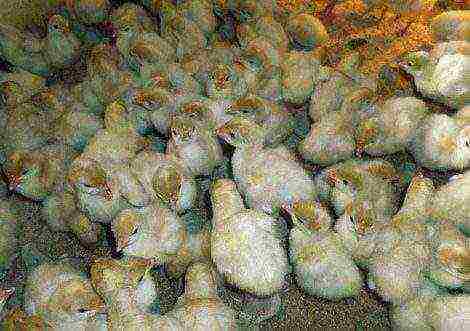Content
- 1 Can daffodils be grown at home?
- 2 How to grow a daffodil at home?
- 3 Choosing a daffodil variety for home distillation
- 4 Container and soil for a domestic daffodil
- 5 Dates for planting daffodils for distillation at home
- 6 How to plant daffodils at home
- 7 Forcing daffodils at home: step by step instructions
- 8 How to water daffodils at home
- 9 Daffodils after distillation
- 10 Planting daffodils outdoors
- 11 Daffodil care
- 12 Reproduction methods
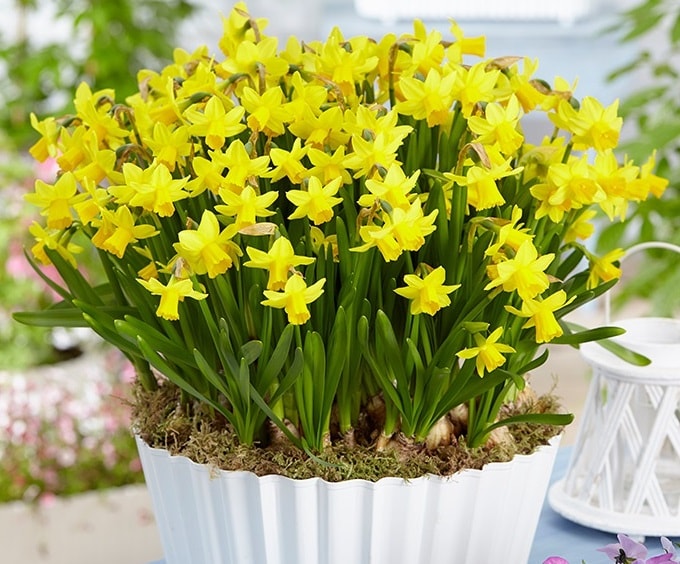
It is believed that daffodils are graceful and unpretentious flowers, decorating only garden plots. But this is not the case! Home conditions may well suit daffodils. You just need to know which plant varieties should be preferred, how to select the right bulbs and plant flowers in pots, how to care for them. So what do you need to know about daffodils growing at home?
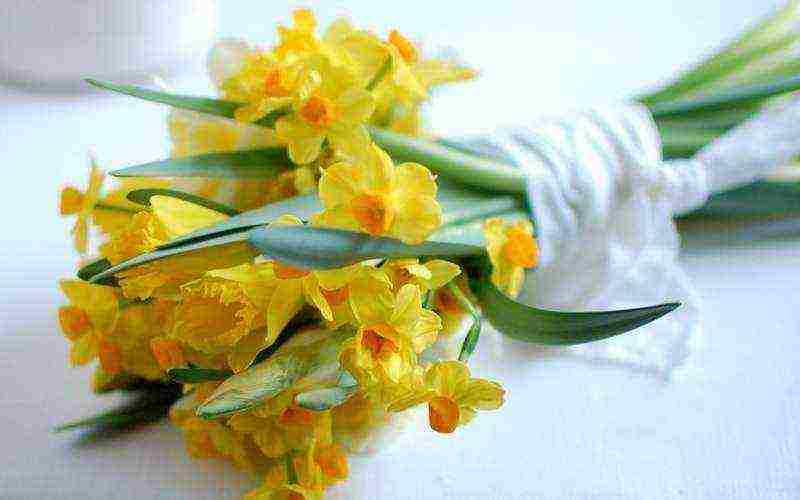
Content:
- What kind of daffodils should you grow at home?
- Selection of bulbs for growing
- Container for planting
- Soil selection
- Planting a flower indoors
- Plant care
- Daffodil care after flowering
- What are indoor daffodils sick with?
What kind of daffodils should you grow at home?
Daffodils can easily adapt to home living conditions, be in pots and delight the inhabitants of the house with wonderful flowers for a long period from winter to spring. But for this you need to know what varieties of daffodils can grow at home. More often than other varieties for indoor conditions, the following varieties are chosen:
- Papery;
- Small pearl;
- Avalanche;
- February gold;
- Ziva;
- Snowball.
Daffodils are also grown at home: "Erlichir", "Verge" or "Geranium".
The most undemanding to the conditions of detention are "Avalansh", "Paper-like", "Ziva". They are also characterized by the longest flowering. Flowers of plants can be colored in various tones: yellow, white, cream, beige. The Avalanche variety, for example, is characterized by the presence of white petals and a yellow heart. "Erlichir" stands out for its peculiar velvety structure of flowers. Daffodils of different varieties can vary in size.
Selection of bulbs for growing
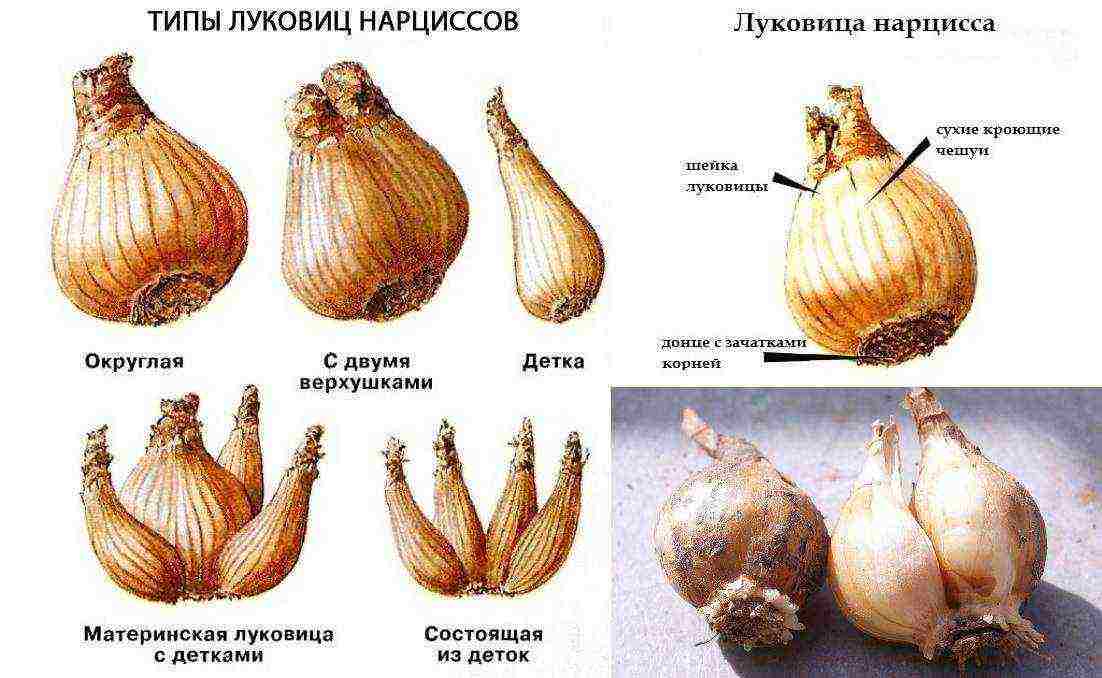
In order for the plant to quickly and easily adapt to indoor conditions, it is necessary to select large, hard bulbs for planting. They should be free from defects: dark spots, scratches, holes, rot. It is better to plant the purchased flower bulbs for indoor cultivation immediately in pots. If the bulbs need to be stored somewhere before planting, then for this they choose a ventilated room where it is dry and warm, since in a damp and cool place the bulbs can take root ahead of time or be attacked by a fungus.
Container for planting
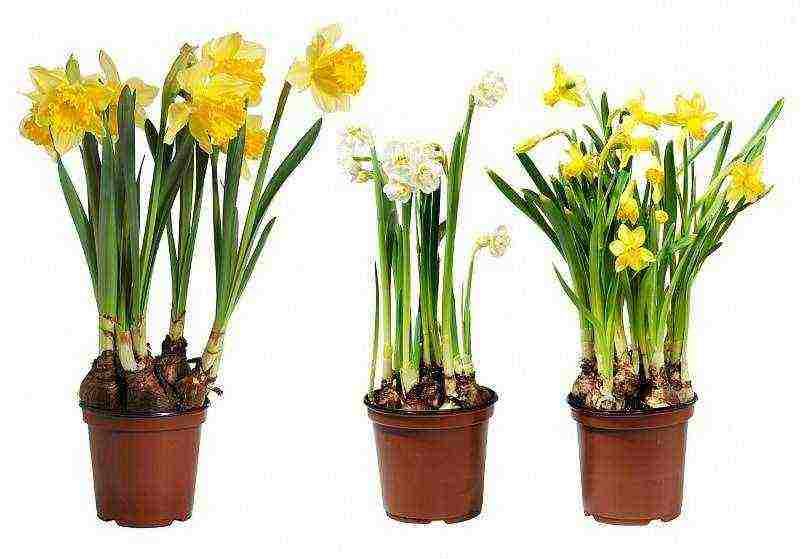
The container for the plant should have a diameter of 15-20 cm and a height of 30 cm with holes for drainage and the included tray. The depth of the container will provide the root system with full growth. If you plan to grow short daffodils (no more than 15 cm), then you can take a smaller pot, but deep enough for growing roots.
Soil selection
Soil, useful for plants, can always be bought at specialized retail outlets. However, garden soil with a soft and crumbly structure is great for a flower. To improve flowering, additional components are added to the soil in the form of sawdust, clay and river sand. Before planting, you can also add components of wood ash or mineral fertilizers to the soil.
Planting a flower indoors
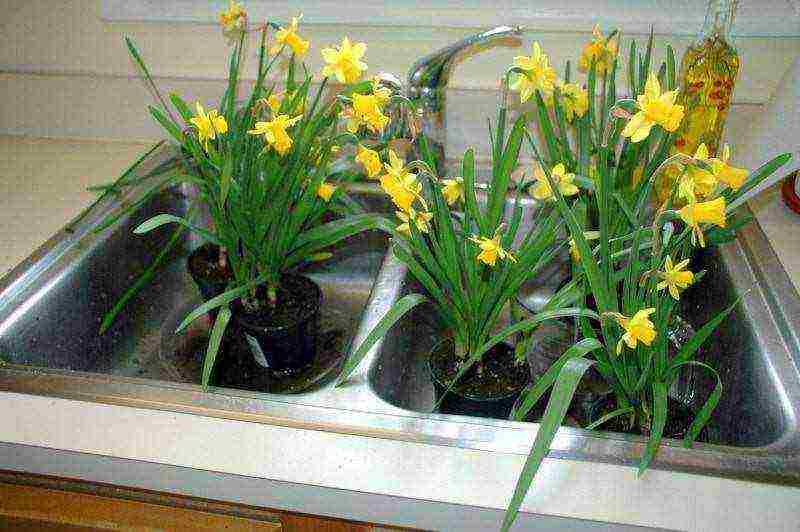
Drainage is placed in the lower part of the pot, which can consist of small pebbles (pebbles), poured 2-3 cm high. Drainage is needed to maximize oxygen advance and remove excess moisture after watering the plant. Earth is poured onto the drainage to the top of the pot. The bulbs are planted by pressing slightly into the ground, while the top of the bulb should rise above the ground.
It is quite possible to plant more than one onion in one pot. This is determined by the size of the pot. So with a container with a diameter of 9 cm, 3 onions 1 cm in size will fit there. The bulbs should not stick together. After finishing planting, moderate watering of the land is carried out, avoiding overflow and decay.
For better rooting of plant germination, a container with a planted flower is placed for 3 months in a room with dark and cool conditions. There, the temperature is maintained within 3-8 ° C. After that, the planted plant must be placed in the light. Since the "papery" daffodil and the "Ziva" variety do not require exposure in the cold, they are placed on the windowsill immediately after planting.
Bulbs are planted according to the expected flowering period. In order to ensure the flowering of the plant before the winter period, they try to plant it in early autumn. For spring flowering, planting is carried out by the end of autumn - the beginning of winter. In order to more accurately determine the planting time of the plant, you should familiarize yourself with the recommendations for this variety.
Plant care
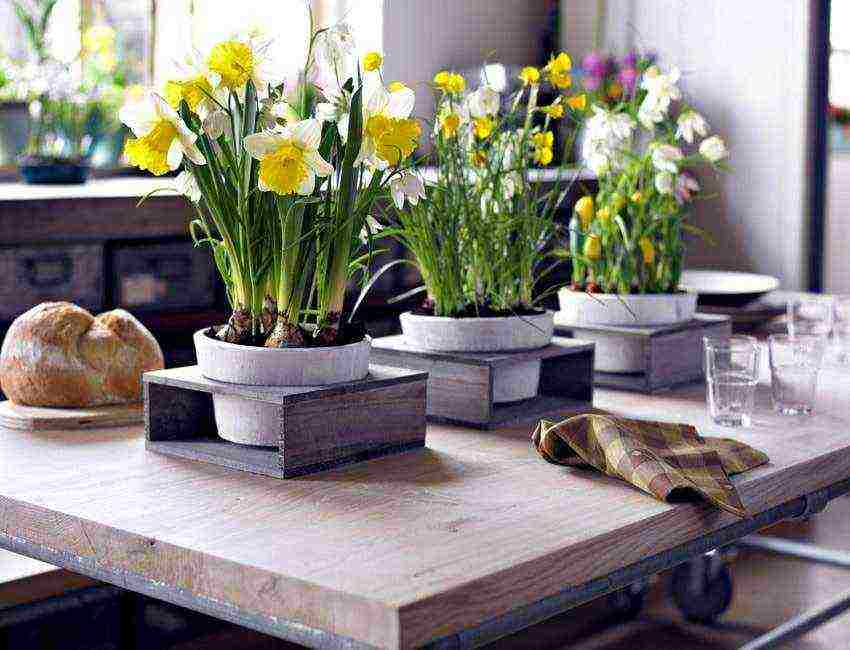
Daffodils grown at home as potted crops are easy to care for. One has only to take into account some recommendations, and beautiful daffodils will delight households and all guests, for example, for the Women's Day on March 8. First of all, you should not place the container with the plant on the windowsill close to other flowers. The fact is that daffodils contain substances with toxic properties that can negatively affect the weak roots of capricious plants in care.
Watering daffodils is necessary immediately after planting. During the rooting of the plant, moderate watering is carried out 1 time within 2 weeks. When the container with daffodil will be in the room on the windowsill, more frequent watering is possible, depending on the drying out of the soil. When watering, it is better to use not cold water and pour it into the pan. During the flowering period, the plant is watered more often, at the end of the period - less often. Watering the daffodil is stopped when the leaves turn yellow.
For better adaptation to home conditions, which consists in rooting and flowering plants, daffodils require feeding with nitrogen-potassium fertilizers. Initially, feeding is done when shoots form, then when buds appear, once every 2 weeks. During the flowering of the plant, fertilizer does not need to be applied. It is important to remember that when flowers appear, the daffodil needs cooler temperature conditions (10-12 ° C) to extend the flowering period, which will last up to 3 weeks.
Daffodil care after flowering
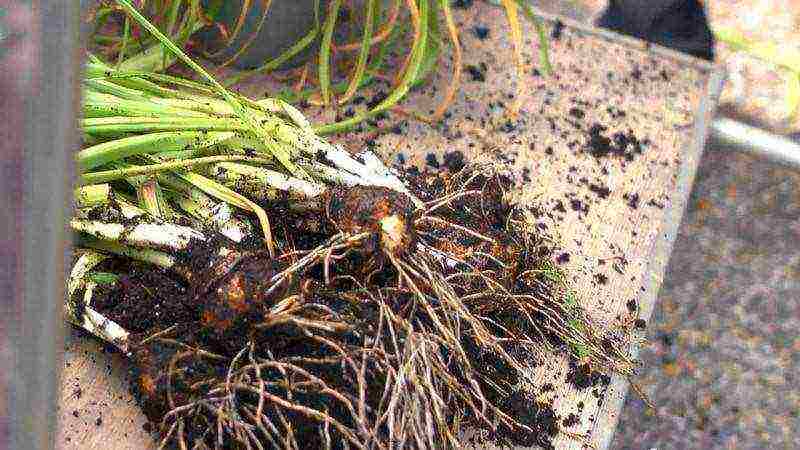
Plants require some care at the end of the flowering time. The dried flowers are cut off.The other parts of the daffodils are allowed to dry completely. Within 10 days, the plant is watered in a moderate mode and top dressing is applied. When the leaves of the daffodil are completely withered, they are carefully removed with a knife (scissors). The container with the plant bulbs in it is taken out to a room with a cooler climate.
The bulbs can also be placed in a small cloth bag or paper wrapping, freeing them from the ground; place where it is cool and dark, for example, in the refrigerator. Daffodil bulbs affected by rot or other disease are thrown away. At home, flowers from the same bulb are grown no more than 3 times. It should be borne in mind that every year with such a distillation, the flowering will not be so abundant every year, and the size of the flowers will decrease. Usually, these bulbs are transferred to garden plots at the beginning of the summer period.
What are indoor daffodils sick with?
Most often, domestic daffodils have a fungal infection. This happens if the plant is over-watered or the planting bulbs are stored in a very warm area. To prevent such a disease, they are treated with fungicidal preparations before planting. Also, ticks, bulbous species of flies, scanty worms - nematodes can become pests of the normal development of a narcissus.
In order to avoid the action of pests, the soil in a container with a plant is loosened, dry and sluggish leaves are removed, and treated with insecticides. In addition to the listed measures to prevent narcissus diseases, you must follow the main rules for caring for the plant:
- watering should not be very large;
- planting materials (bulbs) should not be stored at temperatures exceeding 10 ° C.
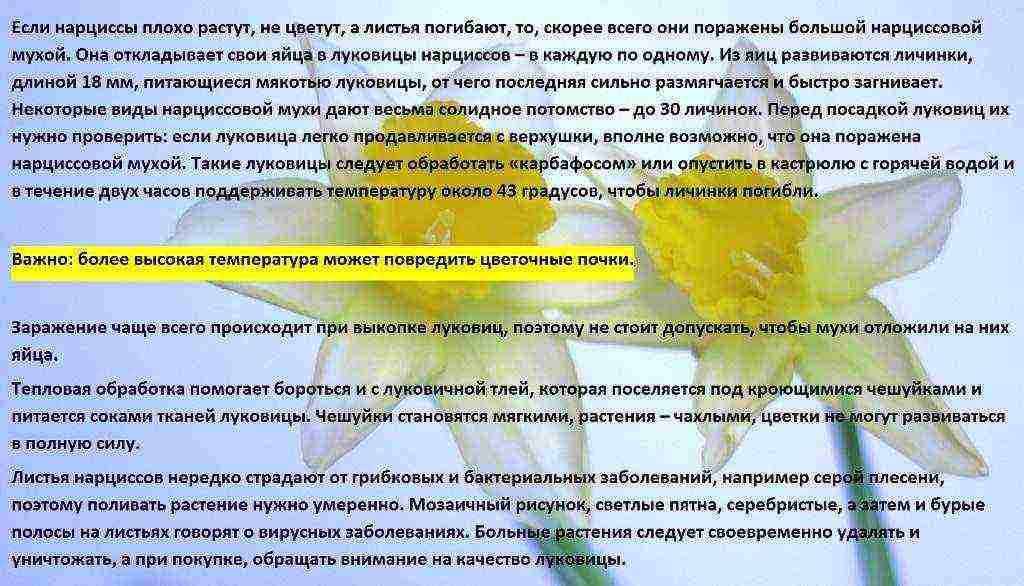
So, it is quite possible to grow a daffodil at home. Forcing a plant does not need special care, time and money. It is only required to follow some rules when planting and leaving, and lovely daffodils will decorate the apartment and become a wonderful home-grown gift.
-
 Choose different varieties of daffodils to plant.
Choose different varieties of daffodils to plant.
- Decide if you want to purchase bulbs that will grow without cold treatment. You can grow the "Papery Daffodil" by simply planting the bulbs in an indoor pot and waiting 2 to 6 weeks. Most other varieties require cold processing, which will extend growth time by an additional 12 weeks.
- Choose your plant size. There are many different sizes of daffodils available, including miniature varieties such as Little Pearl and February Gold. Some large varieties may not be as well suited for indoor planting as heavy flowers may need a support stand.
- Choose a color. Most daffodils are yellow, white, or yellow-white, but there are daffodils that combine a mixture of pink and white, such as daffodils that bloom twice.
-
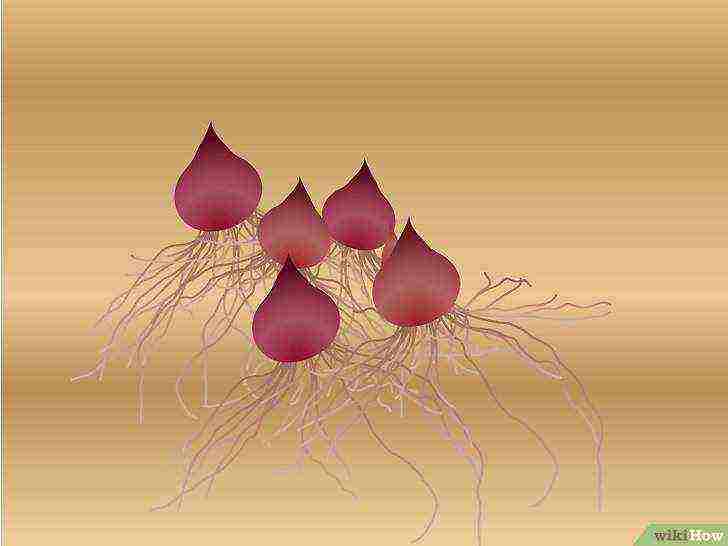
Buy daffodil bulbs. Look for strong and flawless bulbs; don't buy soft or sprouted ones. You may want to buy double bulbs that will grow 2 buds.
-
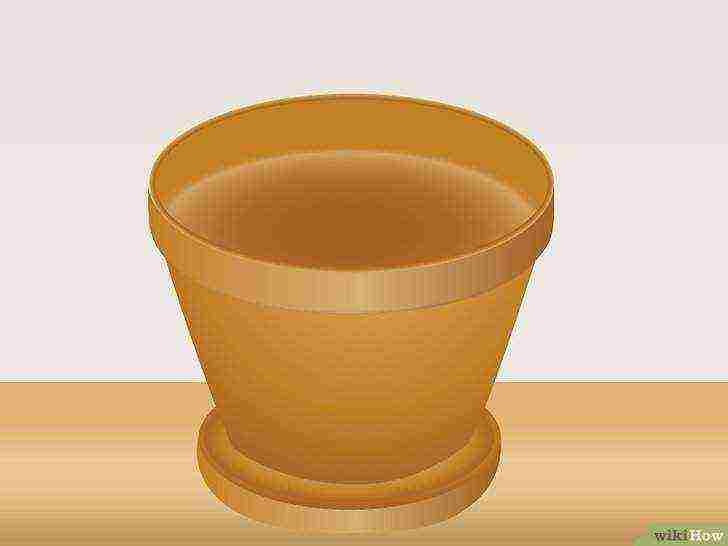 Choose a pot between 15.2 and 20.3 cm.
Choose a pot between 15.2 and 20.3 cm.
in diameter and 30.5 cm in depth with drainage holes and drainage tray. Thanks to the deep pot, the roots have enough room to grow.
- Use a smaller pot if you plan on growing miniature daffodils. 15.2 cm of depth should be sufficient.
-
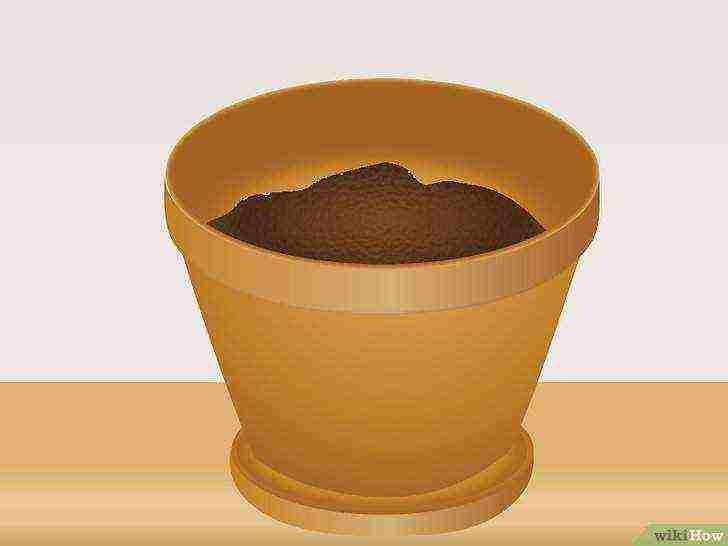
Fill the pot with peat moss potting mix. Leave space at the top for the bulbs.
-
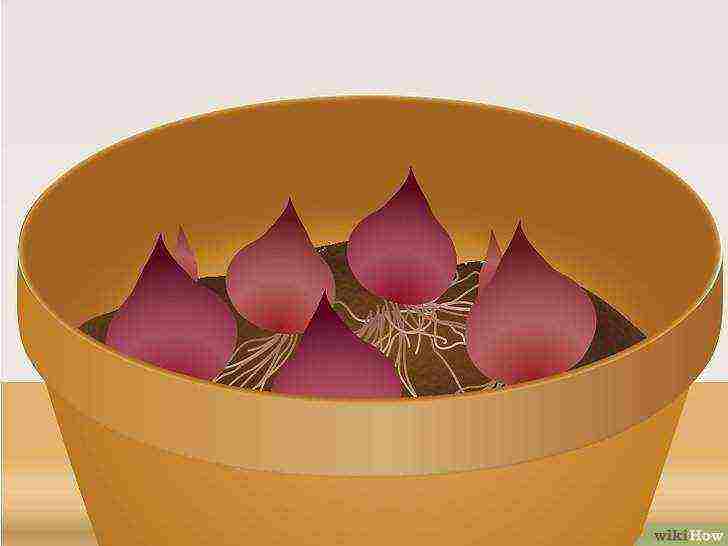
Place the bulbs in a pot. Place the onions with the pointed end up. Use as many bulbs as will fit in the pot so they don't touch each other.
-
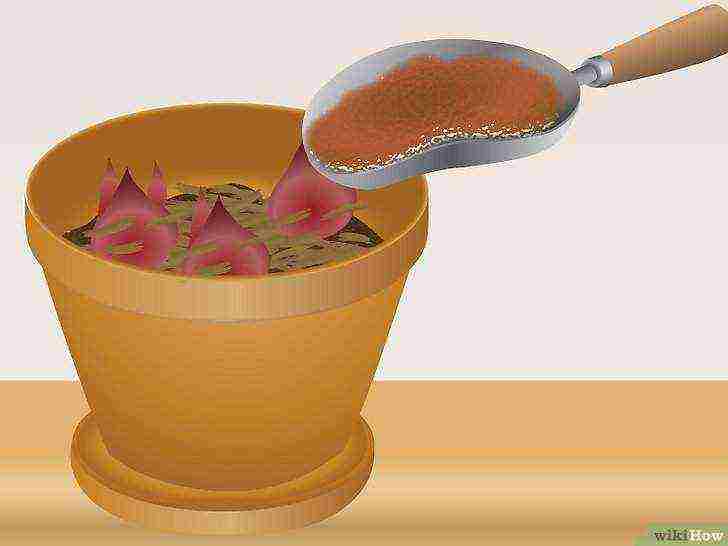
Cover the bulbs loosely with the extra mixture. The pointed tips of the bulbs should be barely visible through the soil.
-

Water well.
-
 Place the pot in a cool storage area.
Place the pot in a cool storage area.
Cold cultivation allows the bulbs to mimic the conditions they would have to endure if you planted them outdoors. The ideal temperature is 35 to 48 degrees F (1.7 to 8.9 degrees C). The bulbs will not grow properly if they are too cold or too hot.
- Cover the potting soil with loose leaves or sawdust to help regulate the temperature.
- Choose a place that is dark and cool. Good options include basements, garages, or refrigerators. In southern climates where the ground does not freeze outside, you can dig a hole and bury the plant outside.
- Keep the soil moist, but don't overdo it.
-
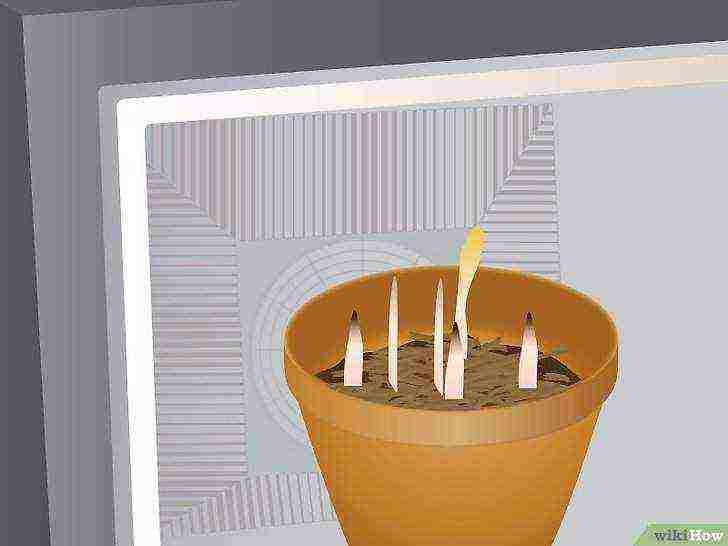
Wait for shoots to appear. Most daffodils will need about 12 weeks of cold treatment. The pot is ready to be moved to a warm room when the sprouts are 5.1 to 7.6 cm tall and white roots emerge from the drain holes in the bottom of the pot.
-
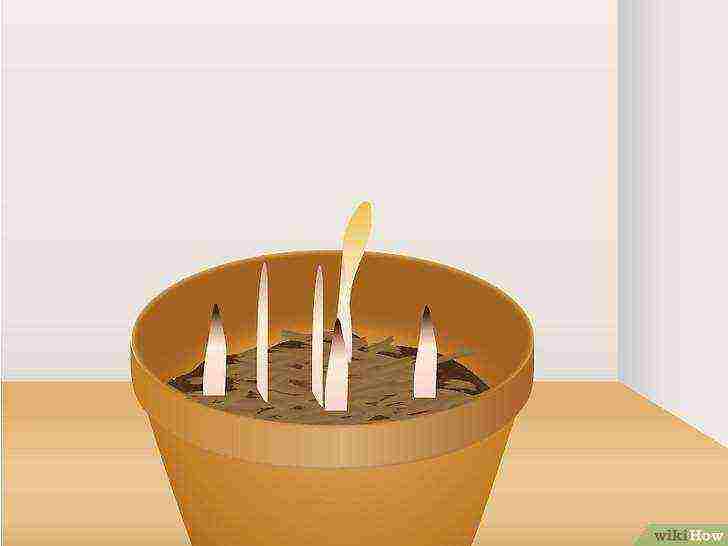
Place the pot in a warm place. The temperature should be around 10 degrees Celsius, and there should be dim light in the room. The pot should stand in a warm place for 2-3 days.
-
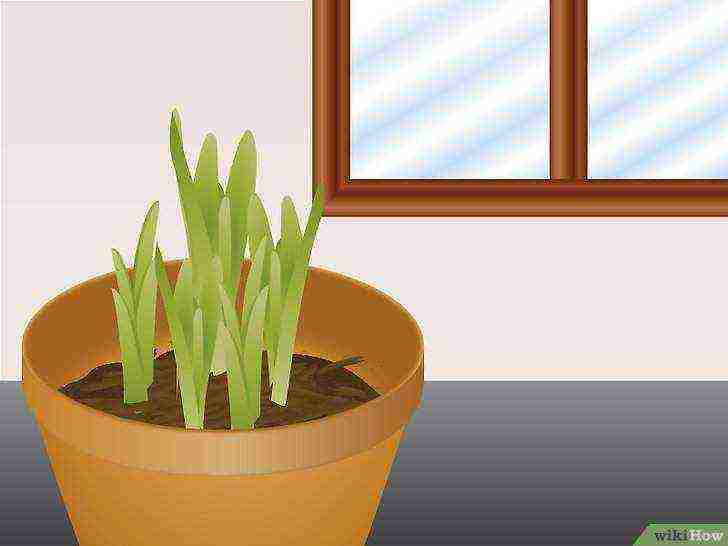 Move the pot to a sunny window.
Move the pot to a sunny window.
The room temperature should be between 15.6 and 18.3 degrees C. Higher temperatures can result in the plants not blooming.
- Turn the pot daily. Narcissus shoots will lean towards the light source. If the pot is rotated frequently, the buds will grow in different directions rather than in one direction.
-
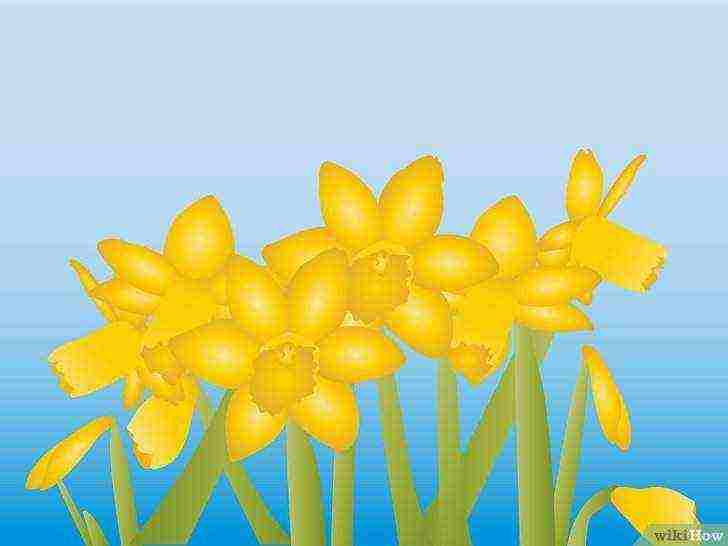 Wait for the daffodils to bloom.
Wait for the daffodils to bloom.
It will take 3 to 5 weeks for flowers to appear after cold processing, but times may vary by cultivar. Once the plants have bloomed, flowering will continue for approximately 1 month.
- After the daffodils are in bloom, move them out of the sun. This will prolong the life of the flowers.
Can daffodils be grown at home?
You will be very surprised, but yes! True, you need to remember that growing daffodils at home from bulbs will require your patience and adherence to a certain sequence of actions. Daffodil bulbs develop and bloom only when the appropriate conditions are met - coolness is required.
In their natural environment, it is enough to plant them in open ground before winter and expect flowering in the spring. But there is an opportunity to enjoy flowering much earlier. To do this, the bulbs are grown indoors in a natural environment (reproducing the conditions under which daffodils grow outdoors). This process is called forcing.
How to grow a daffodil at home?
You will need a little: planting material (daffodil bulbs), a wide container, soil, sawdust, leaves or decorative stones.
Choosing a daffodil variety for home distillation
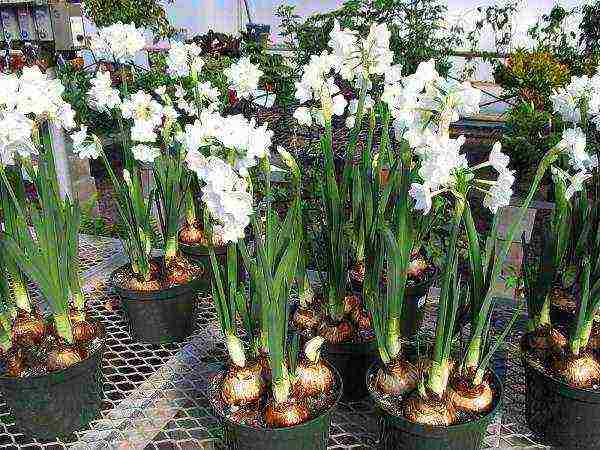
Growing daffodils at home photo
A variety has been developed that does not require cold treatment - papery daffodil. It is enough to plant the onions, put the pot on the windowsill and wait. The forcing process takes 2-6 weeks. Most varieties need cold processing, and their growing time is extended by another 4-6 weeks. When cold processed, daffodils grow taller.
Focus on the desired size. Large varieties are not always good for indoor growing: heavy buds may need props. Miniature bushes will not cause such problems (varieties of February gold, Little pearl.
The colors are varied. Mostly corollas are painted white, yellow or white-yellow. There are mixtures of white and pink, and they will bloom twice.
Pay attention to the quality of the bulbs. They must be strong, dense, without damage. Do not take sprouted ones. They can be double - they give 2 peduncles.
Container and soil for a domestic daffodil
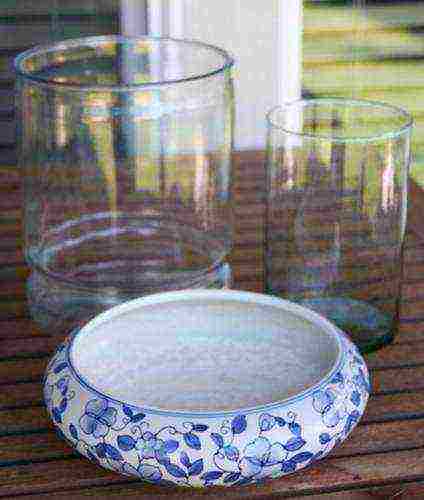
Container for distilling daffodils photo
The roots need enough space for normal growth. Use large pots: 15-20 cm in diameter and about 30-32 cm deep. These settings are suitable for growing large bulbs. For miniature varieties, they are cut in half. Better to take ceramic or clay pots, glass bowls. Wooden boxes can be used.
The soil is required to be soft, but not sticky. You can purchase a special soil mixture (consists of clay, river sand, fertilizer and sawdust). Or take 2 parts of garden soil and 1 part of river sand.

Even decorative pebbles are suitable for forcing daffodils.
For distillation for the holiday, daffodils are planted simply in decorative stones, because the bulbs have a sufficient supply of nutrients and the plants develop well provided sufficient watering.
Dates for planting daffodils for distillation at home
Usually the distillation of daffodils is timed to a certain date.
Terms are divided into:
- Early (planting until mid-October, flowering - for the New Year holidays);
- Medium (planting at the end of January, and you will receive daffodils by March 8 at home);
- Late (planting at the end of March, flowering - for the May holidays).
How to plant daffodils at home
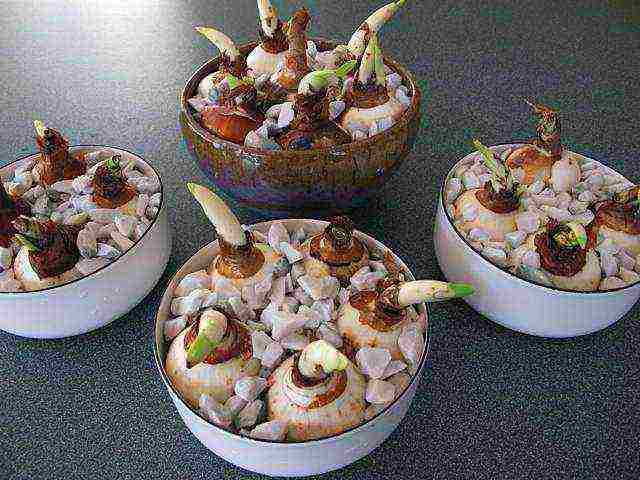
How to grow daffodils at home photos of planted bulbs
Fill the container with soil, but not to the top - leave room for the bulbs. Plant as many bulbs as will fit in the container. You do not need to sprinkle the bulbs on top with soil, it is enough to bury them in the ground by one third of the height. Keep a small distance, the bulbs should not touch each other. Top up with earth. The pointed tops should be slightly visible through the soil. For beauty, the earth can be sprinkled on top with small decorative stones.
Water liberally. Introduce water gently, moving along the edges of the pot. An excellent solution would be to mulch the surface with sphagnum moss, which will allow moisture to evaporate evenly.
Forcing daffodils at home: step by step instructions

Forcing daffodils at home photo
Step one: place the daffodils in a cool, dark place
Planted bulbs should be placed in a cold place to simulate outdoor growing conditions. The bulbs will not develop normally if the temperature is too low or too high. The optimum range is 5-9 ° C. It is important to maintain soil moisture: water occasionally, mulch with a loose layer of leaves or sawdust.
You will need a place where it is dark and cool. Suitable options would be a basement, garage, refrigerator. Do not store fruits or vegetables in the refrigerator next door: they release gas (ethylene) that can harm the bulbs. If you are growing in a brightly lit area, cover the top with a box, black garbage bag, or larger pot to darken.
Cold curing takes about 12 weeks.

How to plant daffodils at home photo
Step two: placing the daffodils in a warmer, lit room
When the sprouts are 5-7 cm long, and white roots appear from the drainage holes, the daffodils are ready to move into the heat. Get used to lighting new conditions gradually. For 2-3 days, place in a place with bright diffused lighting, maintain the air temperature at 10 ° C. Then grow in bright sunlight. The air temperature should be kept in the range of 15-18 ° C. At higher temperatures, flowering may not occur. Expect to bloom in 3-5 weeks (depending on the variety).
How many daffodils bloom at home?
The flowering period will last for about 1 month.
How to water daffodils at home

Narcissus flower photo at home Planting and care
During flowering, daffodils need to be properly cared for. Water as the topsoil dries, but avoid stagnant water.Water liberally during flowering. Loosen the soil periodically. Spray with insecticides for prophylaxis.
Shoots are drawn to the light source. Rotate the pot every day so that the bush grows evenly.
Daffodils after distillation
What to do with daffodils after distillation? At the end of flowering, cut the leaves to the base. After stimulating growth, the bulbs should be planted in open ground. If you bypass this point and put it on forcing again, the daffodils simply will not bloom.
Drawing in the imagination the image of spring, such an integral detail as the flowering of daffodils always pops up. The fragile appearance and delicate aroma will captivate the hearts of flower connoisseurs. And simple planting and caring for daffodils in the open field made him a favorite among all summer residents who want to decorate the spring garden with grace and bright colors.
Planting daffodils outdoors
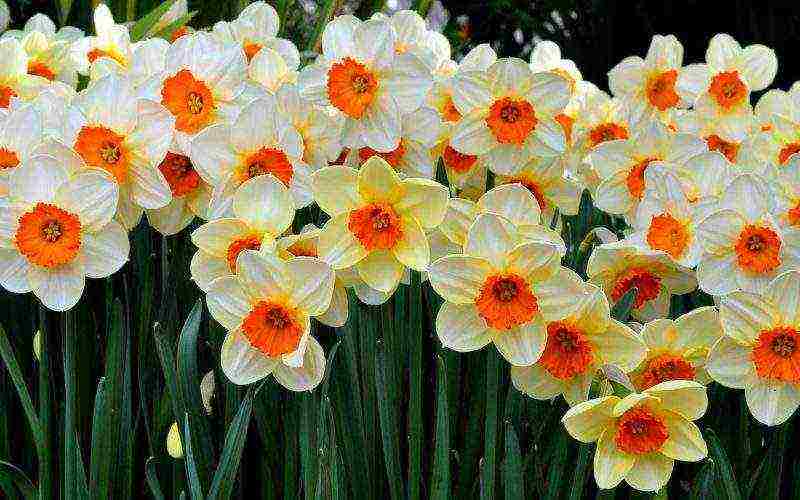
These flowers appear among the first in the front garden, like crocuses and tulips, while being considered the most unpretentious bulbous plants. However, in order to grow a daffodil bright and attractive, you should competently approach even the initial stage - planting.
Place and soil
An important point is the choice of a territory for planting bulbs, taking into account the soil composition. An ideal option would be a well-lit area with neutral loamy soil, where nitroammophoska is additionally introduced at the rate of 60 g per 1 m2, compost or humus. An excess of alkali in the soil is neutralized with dolomite flour at the rate of 200 g per 1 m2, and the increased acidity level is reduced by adding one glass of wood flour to the same area.
Advice! Do not place daffodils after other bulbous crops - tulips, lilies. The optimal predecessors are cereals, legumes and nightshade representatives.
Selection and preparation of planting material
The flower shops offer a wide range of daffodil bulbs of various varieties, which are often sold at great discounts in the spring due to staleness of the goods.

When choosing bulbs, it is recommended to pay attention to:
- the integrity and absence of rotten areas;
- size - with a diameter of less than 5 cm, the bulb must be grown, which will slow down germination;
- hardness.
Before planting, a thorough inspection is carried out and the damaged, underpowered material is rejected. Healthy bulbs are disinfected with a fungicidal agent or a solution of potassium permanganate with a concentration of 1%
Advice! It is better to make the purchase of planting material three months after the flowers have finished blooming.
When and how to plant daffodils?
Daffodils are planted depending on the climate of the region. The basic rule is a soil temperature of 8 to 10 ° C, which is maintained for three weeks while the flower takes root.
Usually, bulbous crops are planted in the fall. You can plant the bulbs in the spring, be sure to keep them in the refrigerator for two months in advance so that the daffodils take root and bloom in the same year.
- Planting in spring. Holes are dug at a distance of 10 cm, subject to future seating, and 20 cm, if further growth of flowers is planned in the next five years. Before placing the bulb, sand is poured into the planting pit to improve the drainage properties of the soil. After planting, the garden soil is mulched with sawdust, straw or cut grass 3-4 cm thick. This will save the grower from unnecessary weeding, loosening and protect the soil from weathering.
- Planting in the fall. In the fall, the bulbs are planted in the same way as in the spring. After the arrival of frosts, the area with flower bulbs is covered with leafy ones from fruit trees or walnuts.
Important! When calculating the depth of the hole, the diameter of the bulb is taken as a basis, which is multiplied by three.
Daffodil care
The quality of care influences the receipt of beautiful, graceful spring flowers with delicate aromatic notes.
Watering and loosening

In dry weather conditions, from the end of spring, daffodils need regular moisture throughout the existence of the aboveground part of the plant: after flowering, watering allows the bulb to accumulate more nutrients. If the site is not mulched, after each irrigation, the beds need to be loosened and weeded.
Temperature
Air and soil temperature conditions affect the beginning and duration of the flowering phase. Optimum temperatures are 15 ° C for air and 10 ° C for soil.
Fertilization
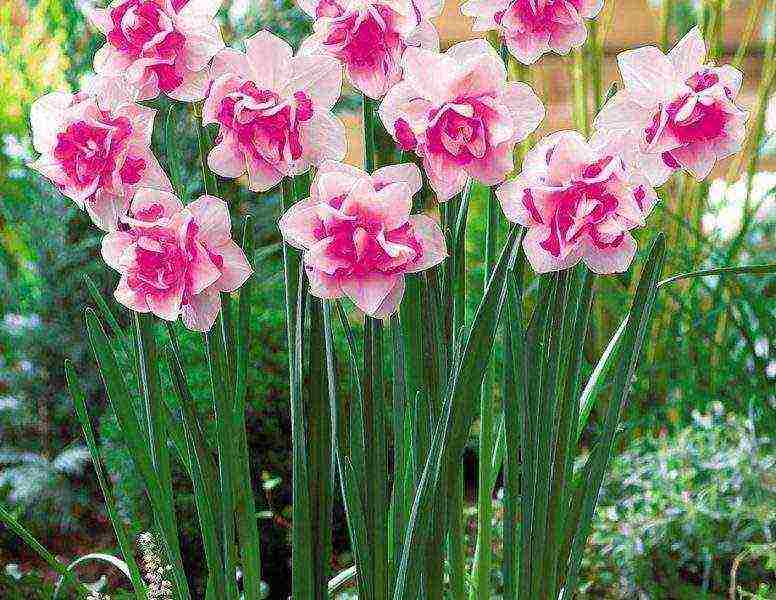
When cultivated in a front garden, early spring flowers need to be fed twice:
- The introduction of a complex of mineral fertilizers in the budding phase is organized: when the working solution is consumed in an amount of 5 liters per 1 m2, superphosphate, potassium sulfate and urea are diluted in 10 liters of water (one teaspoon of each substance).
- A special fertilizer is applied for flowering plants with the addition of nitrogen, phosphorus and potassium: two teaspoons of Agricol and one nitroammofoska are diluted in 10 liters of water.
In rainy weather, liquid fertilizing is replaced by a one-time application of dry fertilizers in early spring - per 1 m2, one teaspoon of potassium sulfate, superphosphate, urea and one tablespoon of wood ash.
Disease and pest control
The culture is affected by fusarium, rot, and is also populated by the narcissus fly, tuberous and onion hoverflies, onion and root mites, slugs, and nematodes.
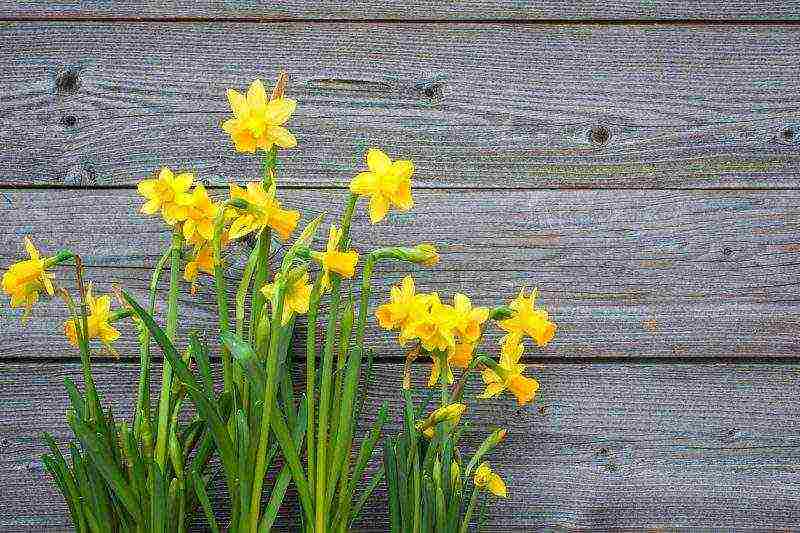
As protective measures, a two-time treatment of plants is carried out:
- Before the start of bud formation, spraying with insecticidal acaricidal preparations is organized according to the manufacturer's instructions.
- Upon completion of flowering, daffodils are treated with a solution of copper sulfate at the rate of 100 g of substance per 10 liters of water, at a consumption of 2 liters of working fluid per 10 m2, or with the preparation "HOM" with the same consumption rate, prepared by diluting 40 g of the product in 10 liters of water.
Transfer
If the florist noticed that the flowers have become smaller and worse in terms of quality, then the need has come to transplant the daffodils. When transplanting, a vegetative method of culture propagation is used - dividing the bulb.
Post-flowering care
Depending on the gardener's plans, two algorithms can be used:
- When leaving the bulbs in the soil for further growth, it is necessary to cut off the ground part after drying, loosen the soil and clear it of weeds. In the second half of August, under conditions of drought, it is necessary to water the site: the bulbs begin to form new roots.
- In the case of transplantation or reproduction, the planting material is excavated. But you need to know when to dig up the bulbs. Harvesting begins after the natural wilting of the leaves, usually in July.
Advice! If the grower has decided to dig up the bulbs, then you should not delay too much time after the yellowing of the leaf plates: the daffodils quickly begin to take root.
Reproduction methods
For breeding daffodils, two methods are used: vegetative and seed.
Vegetative method
During the growing season, two to four are formed from one bulb on average.
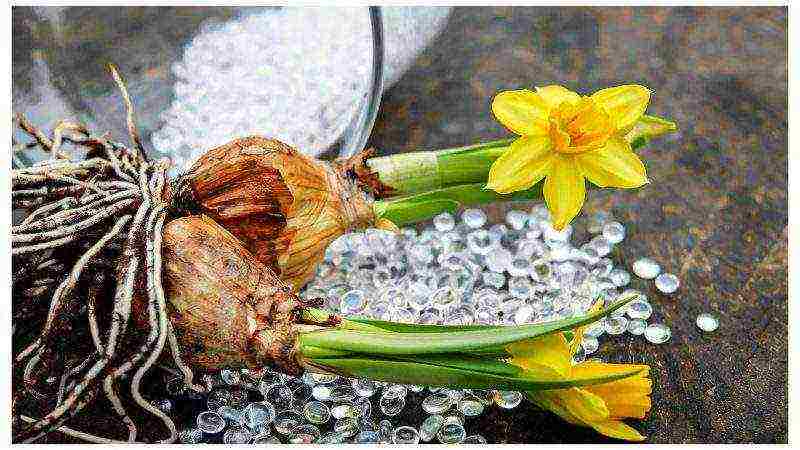
If you want or need to get new copies, you should adhere to the following steps:
- The dug out mother bulbs, together with the daughter ones, are cleaned of wilted residues.
- The planting material is examined to discard and destroy diseased or damaged bulbs.
- Healthy specimens are peeled, washed, disinfected for half an hour in a 1% solution of potassium permanganate, and then divided.
- First, the specimens are separated, falling off without effort, and those that are tightly pressed against the mother ones swing for independent separation.
- If the bulb comes off, sprinkle it with charcoal or activated charcoal.
- Then the separated specimens are dried in a shaded place and stored in a room with a constant temperature not exceeding 17 ºC.
Attention! The time before planting should not be delayed: after a while, a loss of moisture is noted by the bulbs. The optimal storage interval from digging to planting is two months.
Seed method
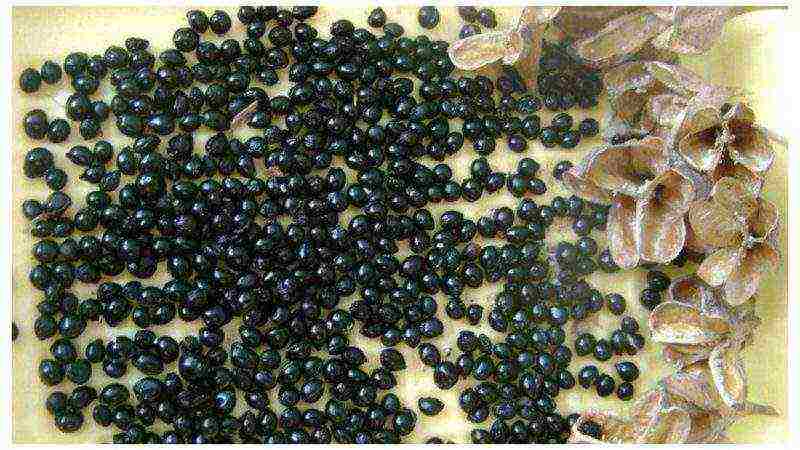
The method consists in sowing freshly harvested, properly not dried seeds in the midst of the summer season or late autumn as follows:
- Seeds are not sown too thickly in a box or open ground to a depth of three seed diameters.
- During the first two years, the seedlings are not disturbed, which allows the bulb to grow stronger.
- At the end of the two-year dormancy, young specimens are planted in a permanent place of growth.
For the first time, such daffodils form buds after at least three years.
Attention! The seed method is permissible only for wild-growing varieties: with this method, varietal qualities are not inherited by new specimens.
So, observing a number of simple rules for growing daffodils, each grower will enjoy the spring tenderness of his garden.
